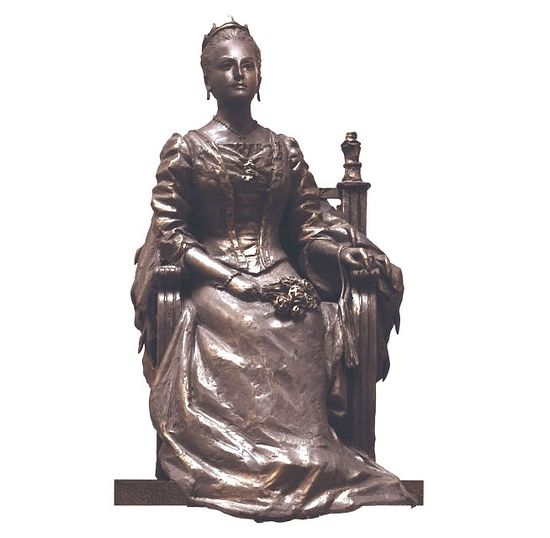
As part of the cross-cultural year between Greece and Russia
and in connection with the 165th anniversary of the birth
of Grand Duchess Olga of Russia, Queen consort of All the Hellenes,
a monument to her will be unveiled in Thessaloniki as a result and in connection with the 165th anniversary of the birth
of Grand Duchess Olga of Russia, Queen consort of All the Hellenes,
of the joint efforts of the Russian Federation’s Ministry of Culture,
the Russian Military Historical Society, the Charitable Foundation
of Ivan Savvidi, and the Federal National Cultural Autonomy
of Greeks in Russia, reports the Russian Military Historical
Society’s official website.
Queen Olga went down in Russia’s and Greece’s history not
only as a lady of royal blood.
Famous for her wide-ranging charity both in Russia and Greece,
she was a true example of Orthodox ministry to the people.
She opened hospitals (including military ones), orphanages,
and infirmaries.
During the Balkan Wars she presided over “The Hospital Movement”
in Greece which gave support to the wounded, ran the Hellenic Red Cross,
with Russian Navy sailors under her special protection.
only as a lady of royal blood.
Famous for her wide-ranging charity both in Russia and Greece,
she was a true example of Orthodox ministry to the people.
She opened hospitals (including military ones), orphanages,
and infirmaries.
During the Balkan Wars she presided over “The Hospital Movement”
in Greece which gave support to the wounded, ran the Hellenic Red Cross,
with Russian Navy sailors under her special protection.
* * *
Grand Duchess Olga Constantinovna (1851-1926) was the wife
of George I of Greece.
Her grandfather was Emperor Nicholas I of Russia, and her
parents were Constantine Nikolaevich and Alexandra Iosifovna.
Her brother was Grand Duke Constantine Romanov, a well-known poet.
of George I of Greece.
Her grandfather was Emperor Nicholas I of Russia, and her
parents were Constantine Nikolaevich and Alexandra Iosifovna.
Her brother was Grand Duke Constantine Romanov, a well-known poet.
The Queen consort devoted her energies to works of charity;
in the city of Piraeus which had a Russian naval base she founded
a naval hospital. Olga opened medical courses for women doctors
which she herself attended as well.
After the beginning of the First World War she moved to Russia where
she worked in military hospitals and cared for the wounded.
Olga Constantinovna inherited a love for the Russian navy from
her father and she kept this love throughout her life.
At the height of the war of the Balkan States with Turkey which
began in 1912, King George fell victim to a terrorist attack.
After his death, Queen Olga Constantinovna (who stayed in
Russia up to the Revolution) resided, among other places,
at the Strelna Constantine Palace (now within the city of St.
Petersburg, overlooking the Gulf of Finland), then the family
home of the Konstantinovichi branch of the Romanovs.
In 1920, after the repose of her grandson Alexander and
following the second accession to the throne of her son,
Constantine I of Greece, Olga became Regent of Greece.
She passed away in 1926. Initially her remains were buried
in the crypt of the Orthodox Church of the Nativity of Christ and St.
Nicholas the Wonderworker in Florence (the Greek Royal Family
used a part of the crypt as a burial vault for monarchs in exile).
In 1936, following the restoration of monarchy in Greece,
the remains of Queen Olga were reburied at Tatoi Palace—an estate
of the former Greek Royal Family near Athens.
Translated by Dmitry Lapa
Pravoslavie.ru
29 / 08 / 2016
http://www.pravoslavie.ru/engl
in the city of Piraeus which had a Russian naval base she founded
a naval hospital. Olga opened medical courses for women doctors
which she herself attended as well.
After the beginning of the First World War she moved to Russia where
she worked in military hospitals and cared for the wounded.
Olga Constantinovna inherited a love for the Russian navy from
her father and she kept this love throughout her life.
At the height of the war of the Balkan States with Turkey which
began in 1912, King George fell victim to a terrorist attack.
After his death, Queen Olga Constantinovna (who stayed in
Russia up to the Revolution) resided, among other places,
at the Strelna Constantine Palace (now within the city of St.
Petersburg, overlooking the Gulf of Finland), then the family
home of the Konstantinovichi branch of the Romanovs.
In 1920, after the repose of her grandson Alexander and
following the second accession to the throne of her son,
Constantine I of Greece, Olga became Regent of Greece.
She passed away in 1926. Initially her remains were buried
in the crypt of the Orthodox Church of the Nativity of Christ and St.
Nicholas the Wonderworker in Florence (the Greek Royal Family
used a part of the crypt as a burial vault for monarchs in exile).
In 1936, following the restoration of monarchy in Greece,
the remains of Queen Olga were reburied at Tatoi Palace—an estate
of the former Greek Royal Family near Athens.
Translated by Dmitry Lapa
Pravoslavie.ru
29 / 08 / 2016
http://www.pravoslavie.ru/engl

Δεν υπάρχουν σχόλια:
Δημοσίευση σχολίου